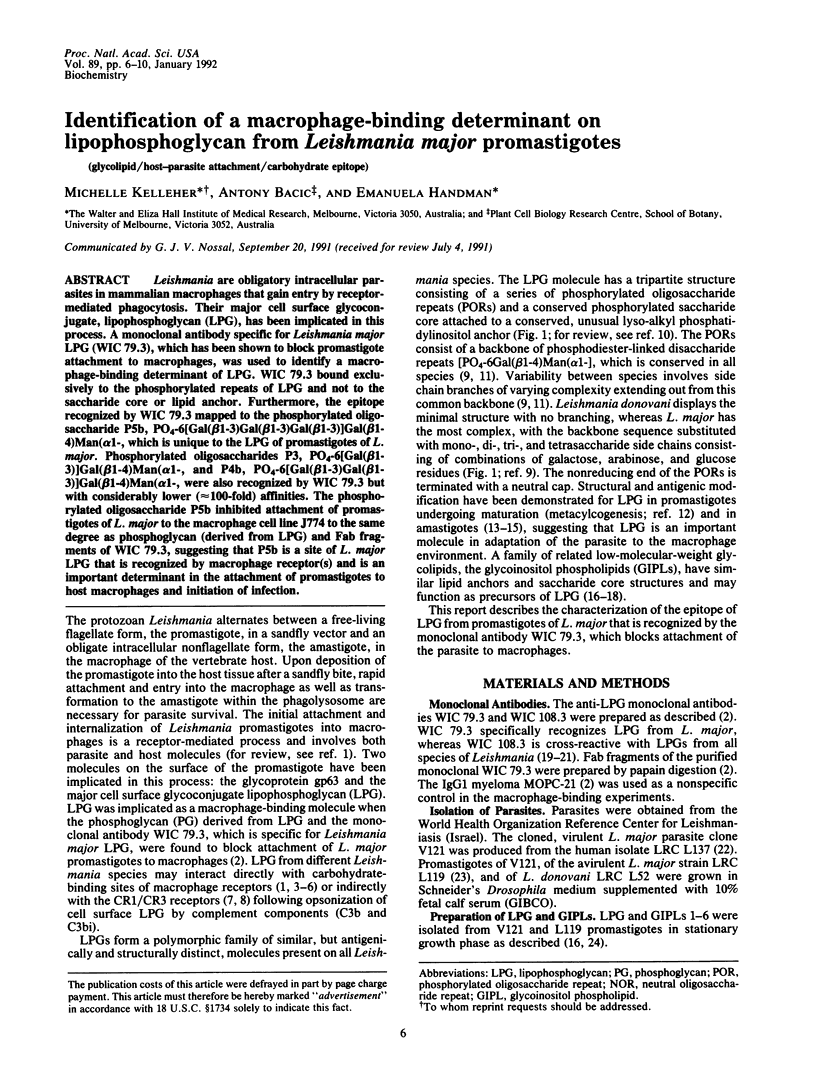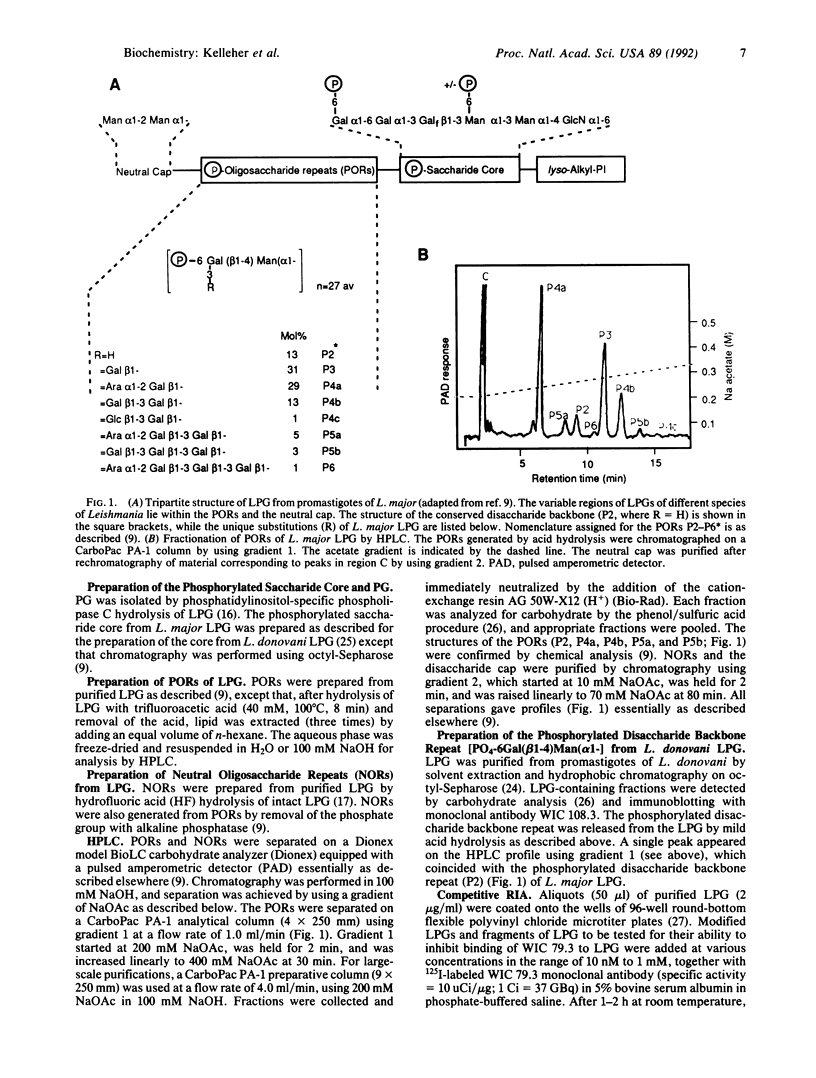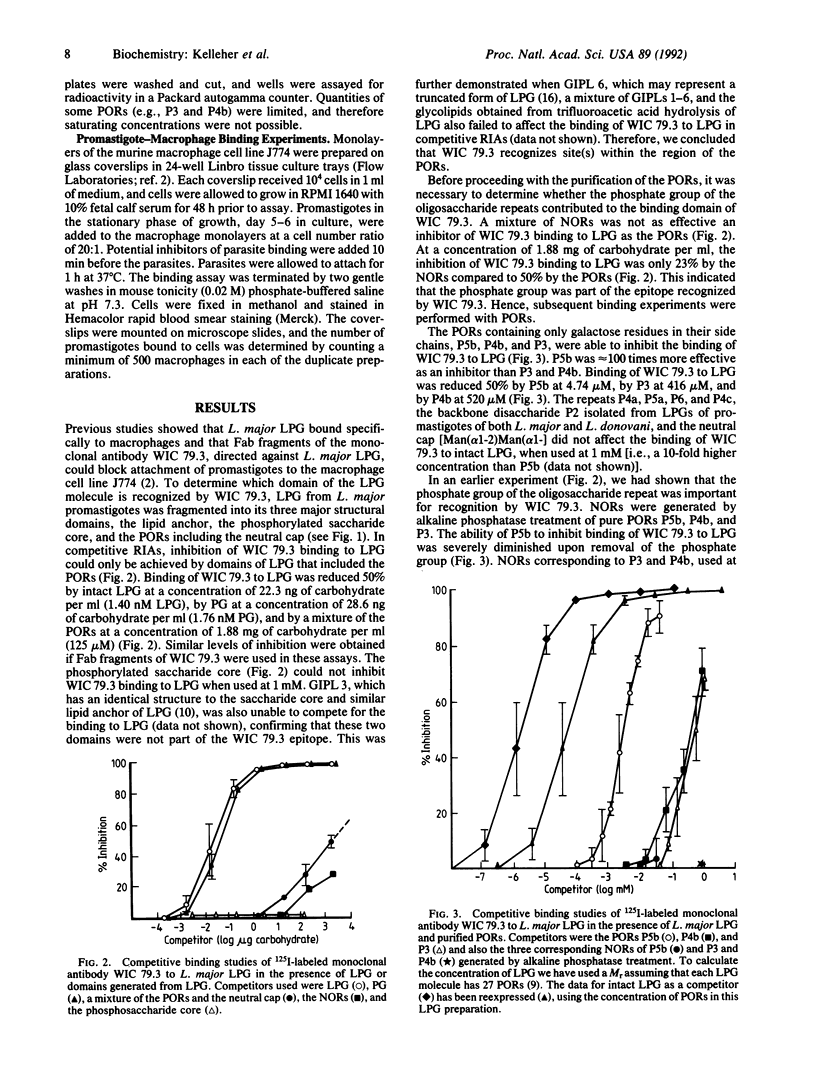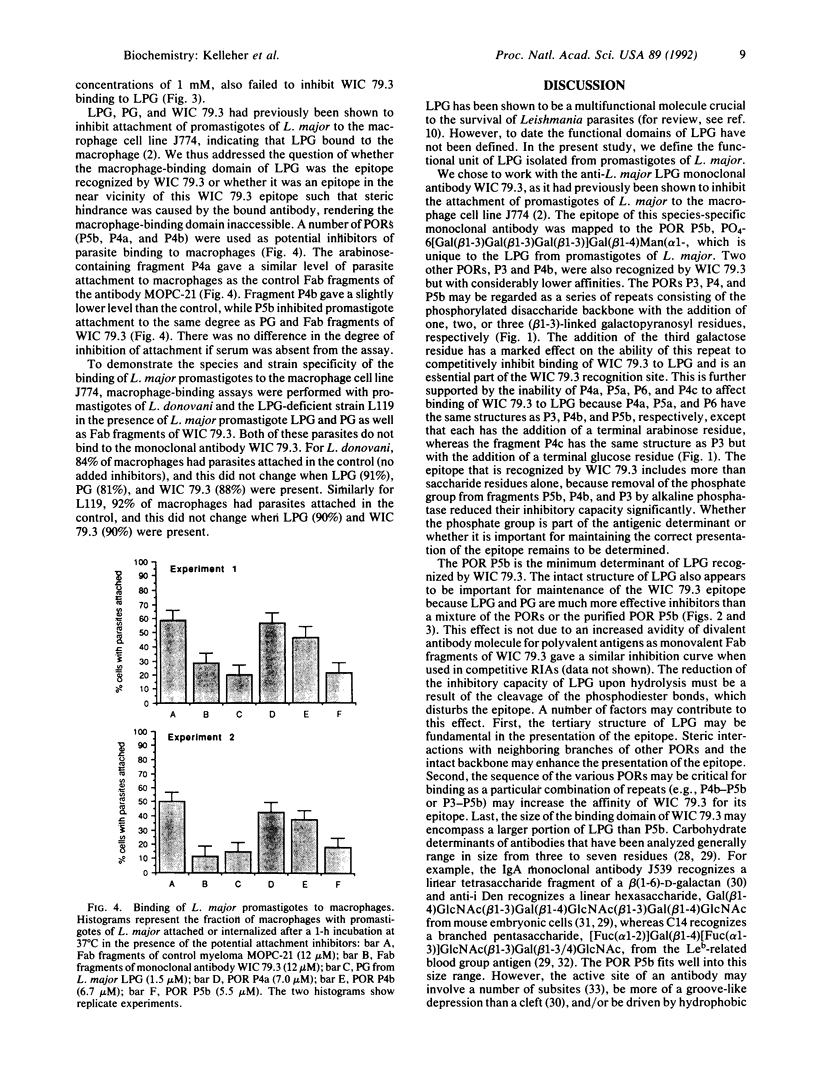Abstract
Leishmania are obligatory intracellular parasites in mammalian macrophages that gain entry by receptor-mediated phagocytosis. Their major cell surface glycoconjugate, lipophosphoglycan (LPG), has been implicated in this process. A monoclonal antibody specific for Leishmania major LPG (WIC 79.3), which has been shown to block promastigote attachment to macrophages, was used to identify a macrophage-binding determinant of LPG. WIC 79.3 bound exclusively to the phosphorylated repeats of LPG and not to the saccharide core or lipid anchor. Furthermore, the epitope recognized by WIC 79.3 mapped to the phosphorylated oligosaccharide P5b, PO4-6[Gal(beta 1-3)Gal(beta 1-3)Gal(beta 1-3)]Gal(beta 1-4)Man(alpha 1-, which is unique to the LPG of promastigotes of L.major. Phosphorylated oligosaccharides P3, PO4-6[Gal(beta 1-3)[Gal(beta 1-4) Man(alpha 1-, and P4b, PO4-6[Gal(beta 1-3)Gal(beta 1-3)] Gal(beta 1-4)Man(alpha 1-, were also recognized by WIC 79.3 but with considerably lower (approximately 100-fold) affinities. The phosphorylated oligosaccharide P5b inhibited attachment of promastigotes of L. major to the macrophage cell line J774 to the same degree as phosphoglycan (derived from LPG) and Fab fragments of WIC 79.3, suggesting that P5b is a site of L. major LPG that is recognized by macrophage receptor(s) and is an important determinant in the attachment of promastigotes to host macrophages and initiation of infection.
Full text
PDF




Images in this article
Selected References
These references are in PubMed. This may not be the complete list of references from this article.
- Blackwell J. M., Ezekowitz R. A., Roberts M. B., Channon J. Y., Sim R. B., Gordon S. Macrophage complement and lectin-like receptors bind Leishmania in the absence of serum. J Exp Med. 1985 Jul 1;162(1):324–331. doi: 10.1084/jem.162.1.324. [DOI] [PMC free article] [PubMed] [Google Scholar]
- Brown A., Feizi T., Gooi H. C., Embleton M. J., Picard J. K., Baldwin R. W. A monoclonal antibody against human colonic adenoma recognizes difucosylated Type-2-blood-group chains. Biosci Rep. 1983 Feb;3(2):163–170. doi: 10.1007/BF01121947. [DOI] [PubMed] [Google Scholar]
- Cooper A., Rosen H., Blackwell J. M. Monoclonal antibodies that recognize distinct epitopes of the macrophage type three complement receptor differ in their ability to inhibit binding of Leishmania promastigotes harvested at different phases of their growth cycle. Immunology. 1988 Dec;65(4):511–514. [PMC free article] [PubMed] [Google Scholar]
- Da Silva R. P., Hall B. F., Joiner K. A., Sacks D. L. CR1, the C3b receptor, mediates binding of infective Leishmania major metacyclic promastigotes to human macrophages. J Immunol. 1989 Jul 15;143(2):617–622. [PubMed] [Google Scholar]
- Feizi T., Childs R. A. Carbohydrates as antigenic determinants of glycoproteins. Biochem J. 1987 Jul 1;245(1):1–11. doi: 10.1042/bj2450001. [DOI] [PMC free article] [PubMed] [Google Scholar]
- Glaser T. A., Moody S. F., Handman E., Bacic A., Spithill T. W. An antigenically distinct lipophosphoglycan on amastigotes of Leishmania major. Mol Biochem Parasitol. 1991 Apr;45(2):337–344. doi: 10.1016/0166-6851(91)90102-c. [DOI] [PubMed] [Google Scholar]
- Glaudemans C. P., Bhattacharjee A. K., Manjula B. N. Monoclonal anti-galactan IgA J 539 binds intercatenarily to its polysaccharide antigen. Observations on the binding of antibody to a macromolecular antigen. Mol Immunol. 1986 Jun;23(6):655–660. doi: 10.1016/0161-5890(86)90103-3. [DOI] [PubMed] [Google Scholar]
- Greenblatt C. L., Slutzky G. M., de Ibarra A. A., Snary D. Monoclonal antibodies for serotyping Leishmania strains. J Clin Microbiol. 1983 Jul;18(1):191–193. doi: 10.1128/jcm.18.1.191-193.1983. [DOI] [PMC free article] [PubMed] [Google Scholar]
- Handman E., Goding J. W. The Leishmania receptor for macrophages is a lipid-containing glycoconjugate. EMBO J. 1985 Feb;4(2):329–336. doi: 10.1002/j.1460-2075.1985.tb03633.x. [DOI] [PMC free article] [PubMed] [Google Scholar]
- Handman E., Greenblatt C. L., Goding J. W. An amphipathic sulphated glycoconjugate of Leishmania: characterization with monoclonal antibodies. EMBO J. 1984 Oct;3(10):2301–2306. doi: 10.1002/j.1460-2075.1984.tb02130.x. [DOI] [PMC free article] [PubMed] [Google Scholar]
- Handman E., Hocking R. E., Mitchell G. F., Spithill T. W. Isolation and characterization of infective and non-infective clones of Leishmania tropica. Mol Biochem Parasitol. 1983 Feb;7(2):111–126. doi: 10.1016/0166-6851(83)90039-7. [DOI] [PubMed] [Google Scholar]
- Handman E., Schnur L. F., Spithill T. W., Mitchell G. F. Passive transfer of Leishmania lipopolysaccharide confers parasite survival in macrophages. J Immunol. 1986 Dec 1;137(11):3608–3613. [PubMed] [Google Scholar]
- Ittah Y., Glaudemans C. P. Preparation of two methyl deoxyfluoro-beta-D-galactopyranosides, and their interaction with galactan-specific immunoglobulin A J539 (Fab'). Carbohydr Res. 1981 Sep 16;95(2):189–194. doi: 10.1016/s0008-6215(00)85575-5. [DOI] [PubMed] [Google Scholar]
- Kabat E. A., Liao J., Burzynska M. H., Wong T. C., Thøgersen H., Lemieux R. U. Immunochemical studies on blood groups--LXIX. The conformation of the trisaccharide determinant in the combining site of anti-I Ma. Mol Immunol. 1981 Oct;18(10):873–881. doi: 10.1016/0161-5890(81)90010-9. [DOI] [PubMed] [Google Scholar]
- Kabat E. A. The nature of an antigenic determinant. J Immunol. 1966 Jul;97(1):1–11. [PubMed] [Google Scholar]
- McConville M. J., Bacic A. A family of glycoinositol phospholipids from Leishmania major. Isolation, characterization, and antigenicity. J Biol Chem. 1989 Jan 15;264(2):757–766. [PubMed] [Google Scholar]
- McConville M. J., Bacic A., Mitchell G. F., Handman E. Lipophosphoglycan of Leishmania major that vaccinates against cutaneous leishmaniasis contains an alkylglycerophosphoinositol lipid anchor. Proc Natl Acad Sci U S A. 1987 Dec;84(24):8941–8945. doi: 10.1073/pnas.84.24.8941. [DOI] [PMC free article] [PubMed] [Google Scholar]
- McConville M. J., Bacic A. The glycoinositolphospholipid profiles of two Leishmania major strains that differ in lipophosphoglycan expression. Mol Biochem Parasitol. 1990 Jan 1;38(1):57–67. doi: 10.1016/0166-6851(90)90205-z. [DOI] [PubMed] [Google Scholar]
- McConville M. J., Homans S. W., Thomas-Oates J. E., Dell A., Bacic A. Structures of the glycoinositolphospholipids from Leishmania major. A family of novel galactofuranose-containing glycolipids. J Biol Chem. 1990 May 5;265(13):7385–7394. [PubMed] [Google Scholar]
- McConville M. J., Thomas-Oates J. E., Ferguson M. A., Homans S. W. Structure of the lipophosphoglycan from Leishmania major. J Biol Chem. 1990 Nov 15;265(32):19611–19623. [PubMed] [Google Scholar]
- Moody S. F., Handman E., Bacic A. Structure and antigenicity of the lipophosphoglycan from Leishmania major amastigotes. Glycobiology. 1991 Sep;1(4):419–424. doi: 10.1093/glycob/1.4.419. [DOI] [PubMed] [Google Scholar]
- Mosser D. M., Vlassara H., Edelson P. J., Cerami A. Leishmania promastigotes are recognized by the macrophage receptor for advanced glycosylation endproducts. J Exp Med. 1987 Jan 1;165(1):140–145. doi: 10.1084/jem.165.1.140. [DOI] [PMC free article] [PubMed] [Google Scholar]
- Niemann H., Watanabe K., Hakomori S. Blood group i and I activities of "lacto-N-norhexaosylceramide" and its analogues: the structural requirements for i-specificities. Biochem Biophys Res Commun. 1978 Apr 28;81(4):1286–1293. doi: 10.1016/0006-291x(78)91275-5. [DOI] [PubMed] [Google Scholar]
- Puentes S. M., Sacks D. L., da Silva R. P., Joiner K. A. Complement binding by two developmental stages of Leishmania major promastigotes varying in expression of a surface lipophosphoglycan. J Exp Med. 1988 Mar 1;167(3):887–902. doi: 10.1084/jem.167.3.887. [DOI] [PMC free article] [PubMed] [Google Scholar]
- Russell D. G., Talamas-Rohana P. Leishmania and the macrophage: a marriage of inconvenience. Immunol Today. 1989 Oct;10(10):328–333. doi: 10.1016/0167-5699(89)90188-6. [DOI] [PubMed] [Google Scholar]
- Sacks D. L., Brodin T. N., Turco S. J. Developmental modification of the lipophosphoglycan from Leishmania major promastigotes during metacyclogenesis. Mol Biochem Parasitol. 1990 Sep-Oct;42(2):225–233. doi: 10.1016/0166-6851(90)90165-i. [DOI] [PubMed] [Google Scholar]
- Sacks D. L., Perkins P. V. Identification of an infective stage of Leishmania promastigotes. Science. 1984 Mar 30;223(4643):1417–1419. doi: 10.1126/science.6701528. [DOI] [PubMed] [Google Scholar]
- Sacks D. L., da Silva R. P. The generation of infective stage Leishmania major promastigotes is associated with the cell-surface expression and release of a developmentally regulated glycolipid. J Immunol. 1987 Nov 1;139(9):3099–3106. [PubMed] [Google Scholar]
- Talamás-Rohana P., Wright S. D., Lennartz M. R., Russell D. G. Lipophosphoglycan from Leishmania mexicana promastigotes binds to members of the CR3, p150,95 and LFA-1 family of leukocyte integrins. J Immunol. 1990 Jun 15;144(12):4817–4824. [PubMed] [Google Scholar]
- Tolson D. L., Turco S. J., Beecroft R. P., Pearson T. W. The immunochemical structure and surface arrangement of Leishmania donovani lipophosphoglycan determined using monoclonal antibodies. Mol Biochem Parasitol. 1989 Jun 15;35(2):109–118. doi: 10.1016/0166-6851(89)90113-8. [DOI] [PubMed] [Google Scholar]
- Turco S. J., Hull S. R., Orlandi P. A., Jr, Shepherd S. D., Homans S. W., Dwek R. A., Rademacher T. W. Structure of the major carbohydrate fragment of the Leishmania donovani lipophosphoglycan. Biochemistry. 1987 Sep 22;26(19):6233–6238. doi: 10.1021/bi00393a042. [DOI] [PubMed] [Google Scholar]
- Turco S. J., Orlandi P. A., Jr, Homans S. W., Ferguson M. A., Dwek R. A., Rademacher T. W. Structure of the phosphosaccharide-inositol core of the Leishmania donovani lipophosphoglycan. J Biol Chem. 1989 Apr 25;264(12):6711–6715. [PubMed] [Google Scholar]
- Turco S. J., Sacks D. L. Expression of a stage-specific lipophosphoglycan in Leishmania major amastigotes. Mol Biochem Parasitol. 1991 Mar;45(1):91–99. doi: 10.1016/0166-6851(91)90030-a. [DOI] [PubMed] [Google Scholar]
- Turco S. J. The leishmanial lipophosphoglycan: a multifunctional molecule. Exp Parasitol. 1990 Feb;70(2):241–245. doi: 10.1016/0014-4894(90)90105-l. [DOI] [PubMed] [Google Scholar]
- Wilson M. E., Pearson R. D. Roles of CR3 and mannose receptors in the attachment and ingestion of Leishmania donovani by human mononuclear phagocytes. Infect Immun. 1988 Feb;56(2):363–369. doi: 10.1128/iai.56.2.363-369.1988. [DOI] [PMC free article] [PubMed] [Google Scholar]
- Young W. W., Jr, Johnson H. S., Tamura Y., Karlsson K. A., Larson G., Parker J. M., Khare D. P., Spohr U., Baker D. A., Hindsgaul O. Characterization of monoclonal antibodies specific for the Lewis a human blood group determinant. J Biol Chem. 1983 Apr 25;258(8):4890–4894. [PubMed] [Google Scholar]
- de Ibarra A. A., Howard J. G., Snary D. Monoclonal antibodies to Leishmania tropica major: specificities and antigen location. Parasitology. 1982 Dec;85(Pt 3):523–531. doi: 10.1017/s0031182000056304. [DOI] [PubMed] [Google Scholar]




